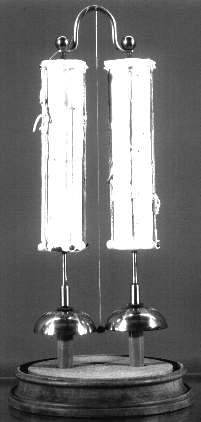According to the university, the bell’s clapper has been oscillating back and forth constantly and quickly for the last 175 years (meaning the Oxford Electric Bell, as it’s called), has rung roughly around 10 billion times. It consists of “dry pile,” which is one of the first kinds of electric batteries. Dry piles were invented by Giuseppe Zamboni in the early 1800s. They use alternating discs of silver, zinc, sulfur, and other materials to generate low currents of electricity. “What the piles are made of is not known with certainty, but it is clear that the outer coating is of sulphur, and this seals in the cells and the electrolyte,” AJ Croft, a former researcher at the Clarendon Laboratory, wrote in a 1984 paper ?describing the bell in the European Journal of Physics. “Zamboni made the piles, whose batteries consisted of about 2,000 pairs of discs of tin foil glued to paper impregnated with zinc sulphate and coated on the other side with manganese dioxide.” The bell was manufactured by London instrument makers, Watkins and Hill, and has a handwritten note that says “set up in 1840”. It was eventually purchased by a researcher, who continued to allow it to ring. But Oxford University believes that the bell was set up something around in 1825. The Guinness Book of World Records has named its power source the “world’s most durable battery.” Presently you can’t be able to hear the sound of bell ringing as the voltage left in the battery is very low. But instead you can see the clapper oscillating back and forth between the bells constantly. Croft says that the battery pulls 1 nanoAmp each time it oscillates between the bell’s sides, which is an remarkably a low amount of current.
A similar type of dry pile batteries were used to power the infrared telescopes during World War II, because a portable, low-current electricity source was necessary. Croft wrote that an Oxford physicist, inspired by the bell, is working to make a similar one to boost up the present era telescopes. On this Croft theorizes that “the clapper seems more likely to wear out than the electro-chemical energy.” At that point, we might finally learn what’s been powering the thing. So the bell rings on and on- and no one can tell when it will stop, leaving behind a mystery to be solved………………..
